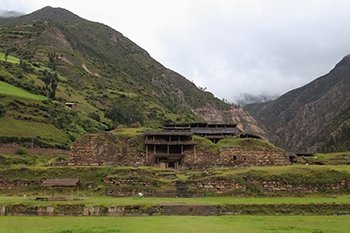
Site visited April 2018. After some more touristy sites in Peru, visiting Chavín was a pure pleasure: no crowds, souvenir sellers, touts and high entrance fees – just greenery, fresh mountain air, few tourists and, of course, a great site with nice museum.
Chavín de Huántar is located at the foothills of Cordillera Blanca mountain range at an elevation of 3200 metres. There are buses from Huaraz that take about three hours. I had a bit of travel fatigue so I decided to take a private transport. I negotiated a fairly good price with hotel staff. It took about two hours from Huaraz with a 4x4 vehicle which was a good choice because the road was in a quite bad condition at times. The highest point of the mountain road, the tunnel of Kahuish, is at 4500 metres. On the way to Chavín we made some short stops. One of the obvious stops is Lake Querococha which is a part of Huascaran National Park WHS.
When I entered the site it started to drizzle but it didn’t spoil my great mood. I paid a modest 15 soles entrance ticket and had a view around me. At first I wondered where are the temples and all but after a while I realised that I was at the backside of the site. The first overall feeling of the site is s bit shabby. There were some negligent roofs and scaffoldings that protect the ancient structures. River flows just beside the site so you could hear the sound of rushing water all the time. I felt almost like having the whole site for myself because there were only 10 other visitors.
Chavín is the greatest achievement of the Chavín culture which is the oldest major culture in Peru. The site itself consists of four temples and three squares in front of the temples. The main temple, temple A or ’El Castillo’, is pyramid like building that was finished around 800 BC. It includes the oldest constructions of Chavin and it is built in many phases. Around the upper part of the temple A used to be the famous stone sculptures or tenon heads representing human faces with feline features. Today only one head sculpture exists on the backside of main temple. Rest of the remaining sculptures, about 30, are on show in the Chavín museum.
Underneath the main temple are many maze-like underground galleries. Some of them are connected with each other and some of them are separate. The tunnels are dark but dim LED lighting make exploring easier. Beside the main temple and between two bigger temples is small temple that contains so called Lanzón which is large carved stone idol. Unfortunately it was not possible to visit that gallery at the time of my visit but replica of it was in the museum.
One of the most amazing features of Chavín is so called Black and White Staircase in front of the temple A and Portal of the Falcons above the staircase. Both of these ceremonial constructions are built with half black and half white stone. Black (north) and white (south) probably refer to the duality of Andean cosmology. Black and white colors of the stones are barely perceptible any more but it is possible to see some lighter and darker hues. Portal of the Falcons consists of carved columns and lintels. On top of the columns are feminine and masculine characters. Underneath the lintels are 16 carved falcons.
Worth mentioning is the Chavín museum (Museo Nacional de Chavín). It is easy to miss because it is located two kilometres from the site. The museum building is new and modern and it is funded partly by Japanese government. The exhibition is compact but it gives you better insight to Chavín site and culture. There are lots of artefacts from the site, the most famous of which are the tenon heads that used to be on the walls of the temple A. One of the highlights is the so called Tello Obelisk with animal carvings. There is also a great collection of conch shells which have been used as trumpet for ritual purposes.
I was really happy with my visit in Chavín. The site is compact enough to see and get a good understanding in two hours. The setting is beautiful and the site has some good information signs for independent travellers. And the museum was the cherry on the cake. For me Chavín was literally like a breath of fresh air among otherwise hot and hectic places in Peru.
More on
Comments
No comments yet.
